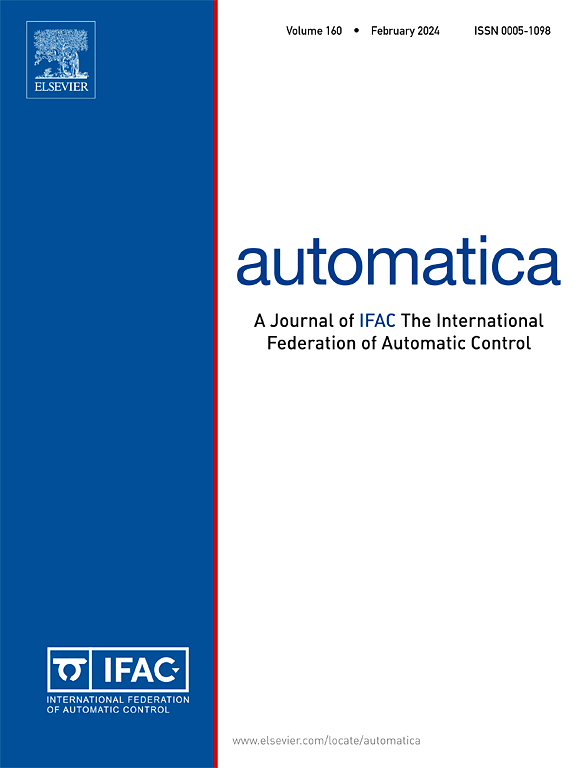2 × 2双曲偏微分方程的反演神经算子
IF 4.8
2区 计算机科学
Q1 AUTOMATION & CONTROL SYSTEMS
引用次数: 0
摘要
非线性算子的深度神经网络近似,通常被称为DeepONet,已经被证明能够近似PDE反演设计,其中单个goursat形式的PDE控制单个反馈增益函数。在耦合双曲偏微分方程的边界控制中,耦合goursat型偏微分方程控制两个或多个增益核,这是迄今为止DeepONet尚未解决的结构。在这篇贡献中,我们通过考虑一个反对流的2 × 2双曲系统,打开了逼近增益核PDE系统的主题,该系统的后退边界控制器和观测器增益是2 × 2核PDE系统的Goursat形式的解。我们建立了从(总共五个)植物的泛函系数到核偏微分方程解的映射的连续性,证明了核偏微分方程的任意接近的DeepONet近似的存在性,并确保了基于DeepONet的近似增益在替换精确的反演增益核函数时保证了稳定性。考虑到反配置边界驱动和感知,我们的l2 -全局指数稳定(GES)控制律需要对控制器和观测器的增益进行深度学习。此外,将反馈律编码到DeepONet中确保了半全局实际指数稳定性(SG-PES),正如我们的结果所建立的那样。神经算子将控制器和观测器增益的计算速度提高了数个数量级。通过仿真验证了其理论证明的稳定能力。本文章由计算机程序翻译,如有差异,请以英文原文为准。
Backstepping neural operators for 2 × 2 hyperbolic PDEs
Deep neural network approximation of nonlinear operators, commonly referred to as DeepONet, has proven capable of approximating PDE backstepping designs in which a single Goursat-form PDE governs a single feedback gain function. In boundary control of coupled hyperbolic PDEs, coupled Goursat-form PDEs govern two or more gain kernels — a structure unaddressed thus far with DeepONet. In this contribution, we open the subject of approximating systems of gain kernel PDEs by considering a counter-convecting 2 × 2 hyperbolic system whose backstepping boundary controller and observer gains are the solutions to 2 × 2 kernel PDE systems in Goursat form. We establish the continuity of the mapping from (a total of five) functional coefficients of the plant to the kernel PDEs solutions, prove the existence of an arbitrarily close DeepONet approximation to the kernel PDEs, and ensure that the DeepONet-based approximated gains guarantee stabilization when replacing the exact backstepping gain kernel functions. Taking into account anti-collocated boundary actuation and sensing, our -globally-exponentially stabilizing (GES) control law requires the deep learning of both the controller and the observer gains. Moreover, the encoding of the feedback law into DeepONet ensures semi-global practical exponential stability (SG-PES), as established in our result. The neural operators (NOs) speed up the computation of both controller and observer gains by multiple orders of magnitude. Its theoretically proved stabilizing capability is demonstrated through simulations.
求助全文
通过发布文献求助,成功后即可免费获取论文全文。
去求助
来源期刊

Automatica
工程技术-工程:电子与电气
CiteScore
10.70
自引率
7.80%
发文量
617
审稿时长
5 months
期刊介绍:
Automatica is a leading archival publication in the field of systems and control. The field encompasses today a broad set of areas and topics, and is thriving not only within itself but also in terms of its impact on other fields, such as communications, computers, biology, energy and economics. Since its inception in 1963, Automatica has kept abreast with the evolution of the field over the years, and has emerged as a leading publication driving the trends in the field.
After being founded in 1963, Automatica became a journal of the International Federation of Automatic Control (IFAC) in 1969. It features a characteristic blend of theoretical and applied papers of archival, lasting value, reporting cutting edge research results by authors across the globe. It features articles in distinct categories, including regular, brief and survey papers, technical communiqués, correspondence items, as well as reviews on published books of interest to the readership. It occasionally publishes special issues on emerging new topics or established mature topics of interest to a broad audience.
Automatica solicits original high-quality contributions in all the categories listed above, and in all areas of systems and control interpreted in a broad sense and evolving constantly. They may be submitted directly to a subject editor or to the Editor-in-Chief if not sure about the subject area. Editorial procedures in place assure careful, fair, and prompt handling of all submitted articles. Accepted papers appear in the journal in the shortest time feasible given production time constraints.
 求助内容:
求助内容: 应助结果提醒方式:
应助结果提醒方式:


